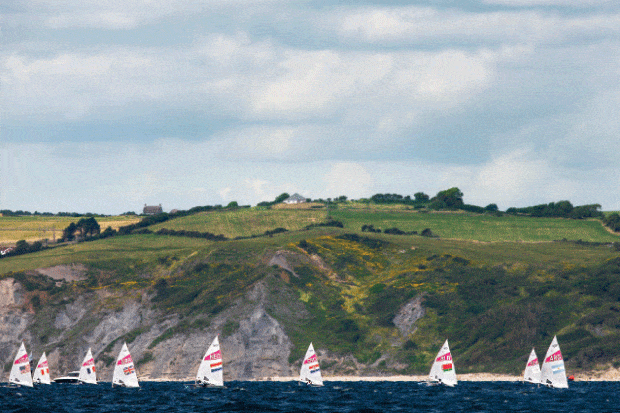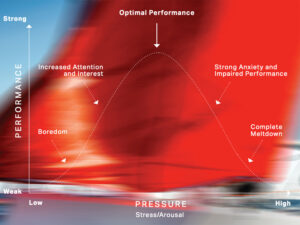
Catching Shoreline Wind
Offshore and side-shore winds create the trickiest conditions in which to race, especially when marks are set very close to the shoreline. Theories abound about how winds behave as they interact with the terrain, so Racer Rob confronts the Doctor to get his take on which way the shift might just go.
Rob: Doc, we have a problem.
Doc: Nice to see you too, Rob. What’s the problem?
Rob: I’ve been reading again.
Doc: Yes, that would usually do it.
Rob: … and I’m getting more confused about which side of the track is favored when the wind is coming offshore. You see, when I was growing up a friend told me that the wind will always try to cross the shoreline at 90 degrees. That is, if the wind is coming off the shore at other than 90 degrees to the shoreline, then as it crosses the shore, the breeze will tend to shift, left or right, toward the 90-degree angle.
Doc: Yes …
Rob: Well like I said, I’ve been doing some reading, and I’ve found a long list of writers who tell me that, when leaving a shoreline, wind bends only in one direction, dependent on hemisphere, of course. Looking upwind, it always bends to the left in the northern hemisphere—so you should work the left-hand side of the track as you come in to the top mark. It has something to do with the Coriolis effect, which I honestly never really understood, and the wind accelerating as it leaves the land.
Doc: … and those writers would be?
Rob: Frank Bethwaite, David Houghton, Ed Adams, for example—clued-in guys.
Doc: Go on.
Rob: Well, there are some other really smart guys who still say that the wind crosses the shore at 90 degrees.
Doc: Such as?
Rob: Buddy Melges, Dave Dellenbaugh, Jon Alofsin. So which is it? They can’t all be right!
Doc: You might need to take a seat. I have some bad news for you.
Rob: My heart? My sanity?
Doc: There are other forces at work.
Rob: Yep, I need a seat.
Doc: Have you read “The Sailor’s Wind” by Stuart Walker? He takes yet another view. He says you should work the right-hand side going upwind into a windward shore. He argues that, as a boat approaches an upwind shoreline and moves into the “gusting zone,” the change in angle will come from upper-level airflow reaching the surface as gusts, and that occurs due to increased turbulence around the shoreline area. That upper-level flow is right-shifted compared to the surface flow, and therefore you will get gusts that are right-hand shifts.
Rob: My head hurts.
Doc: But wait—there’s more! There are a few studies by weather specialists that have tried to work out the problem. Their conclusions are that the wind can shift left or right compared to the wind angle onshore dependent mostly on the temperature of the sea.
Rob: So what you’re saying is that there are four groups of experts, and they each say something different about which way the wind shifts when it’s coming offshore. One group says the wind bends toward 90 degrees, the second says it shifts left (in the northern hemisphere), the third says it shifts right, and the last group says it shifts right or left.
Doc: Yes. That about covers it.
Rob: I give up. Just tell me what to do in an offshore wind.
Doc: You don’t think there are enough opinions already?
Rob: Clearly not.
Doc: All right. I can’t say I don’t have an opinion. So I will serve it up for what it’s worth. Let’s start with the theories. The Coriolis effect is well documented. We are all on this huge merry-go-round called Earth, and the effect of the world spinning is that as wind flow accelerates or slows down, its direction changes. In the northern hemisphere, high-velocity breeze is shifted right compared to lower velocity breeze all else being equal. And that last part is important, because it is very rare that all else is equal. So many things affect the wind.
One of the big questions is that of scale. The meteorologists with whom I have spoken all seem to think in scales of tens or hundreds of miles, and when I ask about predictions for an area of a couple of miles close to shore, the nice ones give me a very paternal smile, say “there, there,” and gently pat my head. For instance, the studies that showed the wind could shift left or right depending on water temperature were based on data from land-based stations compared to measurement points 10 to 50 miles offshore. There seems to be very little data about genuinely close-to-shore effects.
I did manage to track down the probable source of the “90-degree angle” theory, though. A guy named Alan Watts wrote about it in his 1965 book, “Wind and Sailing Boats.” He described the principal as “shore-side refraction,” which he said worked the opposite to the refraction of light. Unfortunately, the formula he provided supported refraction of light—Snell’s Law—and not “shore-side refraction.” He gave no references, and I have not yet tracked down any explanation or source that I can use as validation.
Rob: Enough on the theories already. Just give me an answer.
Doc: I’m not quite finished yet. The other theory is whether or not gusts always shift in one direction (because they are upper-level air brought to the surface). I haven’t yet found any observational studies that support the idea. A British meteorologist, Mike Brettle, reviewed some studies and set up one of his own to test the idea. His results lined up with the previous studies, i.e., that gusts demonstrated no consistent change in direction. In fact, the study showed that the change in angle for gusts produced roughly a normal distribution centered on a mean of zero.
Rob: If that were true, that would blow Walker’s theory out of the water.
Doc: That’s the thing. There are too many smart people talking about this and coming up with different answers for us to either discount any theory or to accept any as the “one true faith.” Walker is one of the most thoughtful and well-considered exponents of yacht racing theory, and you ignore his ideas at your peril.
Rob: Still fence-sitting, I see.
Doc: OK, so here are my conclusions. Firstly, all of the base data is observational—specific venues, specific conditions. What then happens is we do what humans do; we try to explain what’s going on and create theories. And sometimes those theories have proved to be pretty dodgy explanations of what we have observed.
All of the explanations being offered for what happens to wind coming offshore are thoughtful and logical attempts to marry a rational explanation to a series of observations. Good observations are valid, but the theories chosen as explanatory might not actually fit the bill. That leaves us with a problem. Without reliable theory, we can’t go to new locations and easily figure out what is going on, but I think that is the reality.
So my view is do the observation and get the local knowledge. The best data will be venue- and wind-condition specific, and not based on any particular theory. There are usually so many venue-specific anomalies that generalized theories are hard to apply anyway. The trick is working out which are the dominant factors when.
If you come across people who tell you that they have “the answer,” then listen for the data (the case examples and the observations) and take the explanations with a fairly healthy dose of salt.
Rob: [long pause] All of this talk and what I get is “go and look.”
Doc: Yes, Rob. It’s time to put the books away, go sailing, and collect your own data.
Reference List
“90 degrees”
Alofsin, J. (2001) Keep it simple upwind. Sailing World, May 2001 – p.65
Dellenbaugh, D. (2007). Speed and smarts, May/June 2007, #97 – p.5.
Melges, B. & Mason, C. (1983). Sailing Smart: Winning Techniques, Tactics, And Strategies – p.108. New York: Henry Holt.
Watts, A. (1965). Wind and sailing boats – p.173. Great Britain: Adlard Coles.
“Shifts left”
Adams, E. (1995). Choosing sides: The art of understanding geographic windshifts. Sailing World, May 1995 – pp.62-65.
Bethwaite, F. (1993). High Performance Sailing – pp.86-87. Camden, ME: International Marine.
Houghton, D. & Campbell, F. (2005). Wind Strategy (3rd ed) – p.14. Chichester, England: Wiley.
“Shifts right”
Walker, S. (1998). The Sailor’s Wind – pp.108-111. New York: Norton.
Met studies
Brettle, M. J. (1994). An investigation of possible systematic wind-direction changes associated with sudden increases in wind speed. Met Apps, 1 – pp.179-183.
Francis, P. E. (1970). The effect of changes in atmospheric stability and surface roughness on off-shore winds over the east coast of Britain. Met Mag, 99 – pp.130-137.









